How to Get Rid of Acne Scars for Good
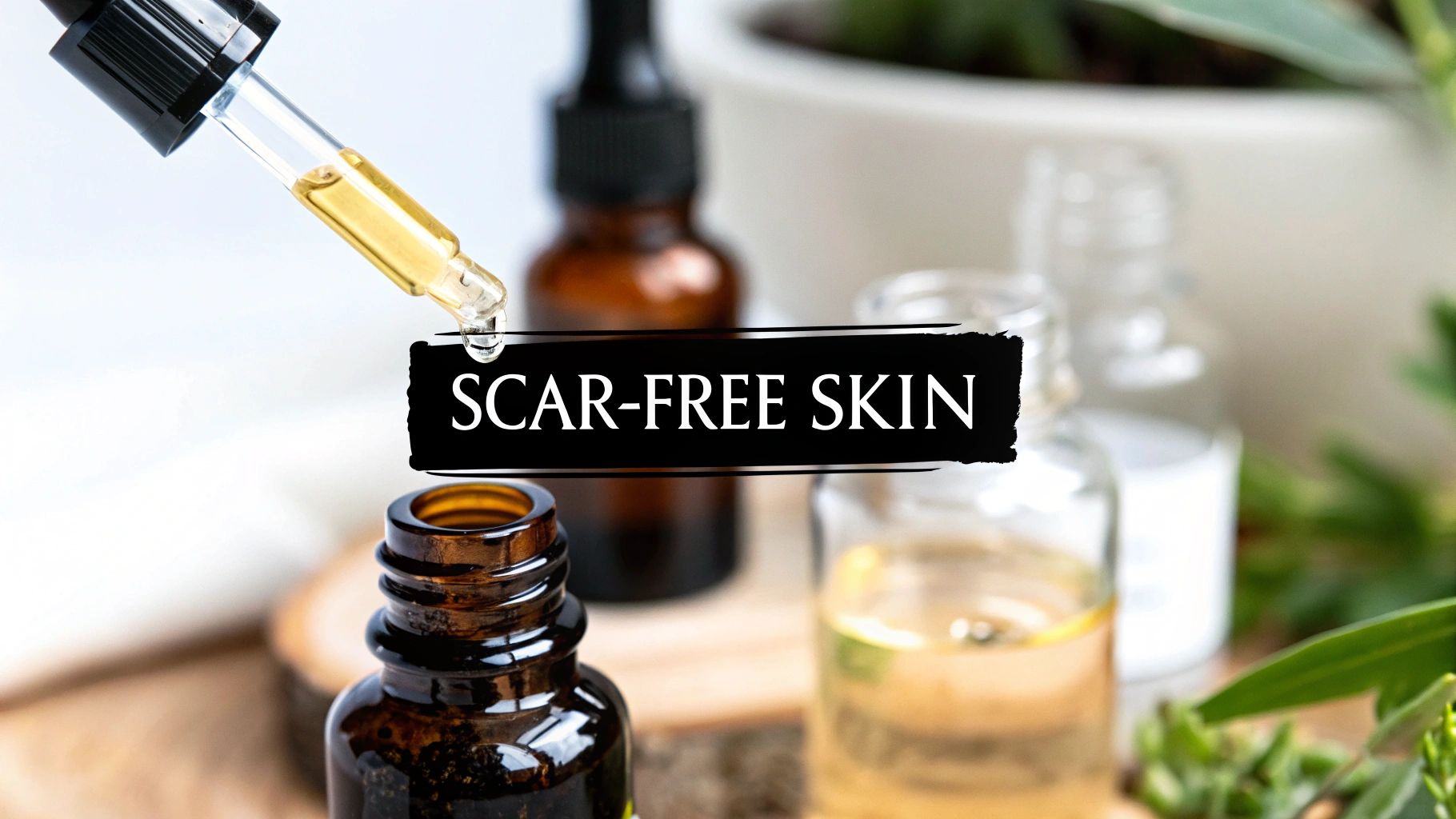
Before you can really tackle the marks left behind by breakouts, you have to know what you’re up against. It's a common mistake to lump all post-acne marks into the "scar" category, but doing so can lead you down the wrong treatment path. The first, most crucial step is figuring out if you're dealing with a true scar or simple discoloration.
So, what's the difference? True scars are all about texture—think dents, pits, or raised bumps. Discoloration, on the other hand, refers to the flat red, purple, or brown spots that linger after a pimple has healed. This isn't just semantics; it's the key to finding a solution that actually works.
First, Understand Your Acne Scars
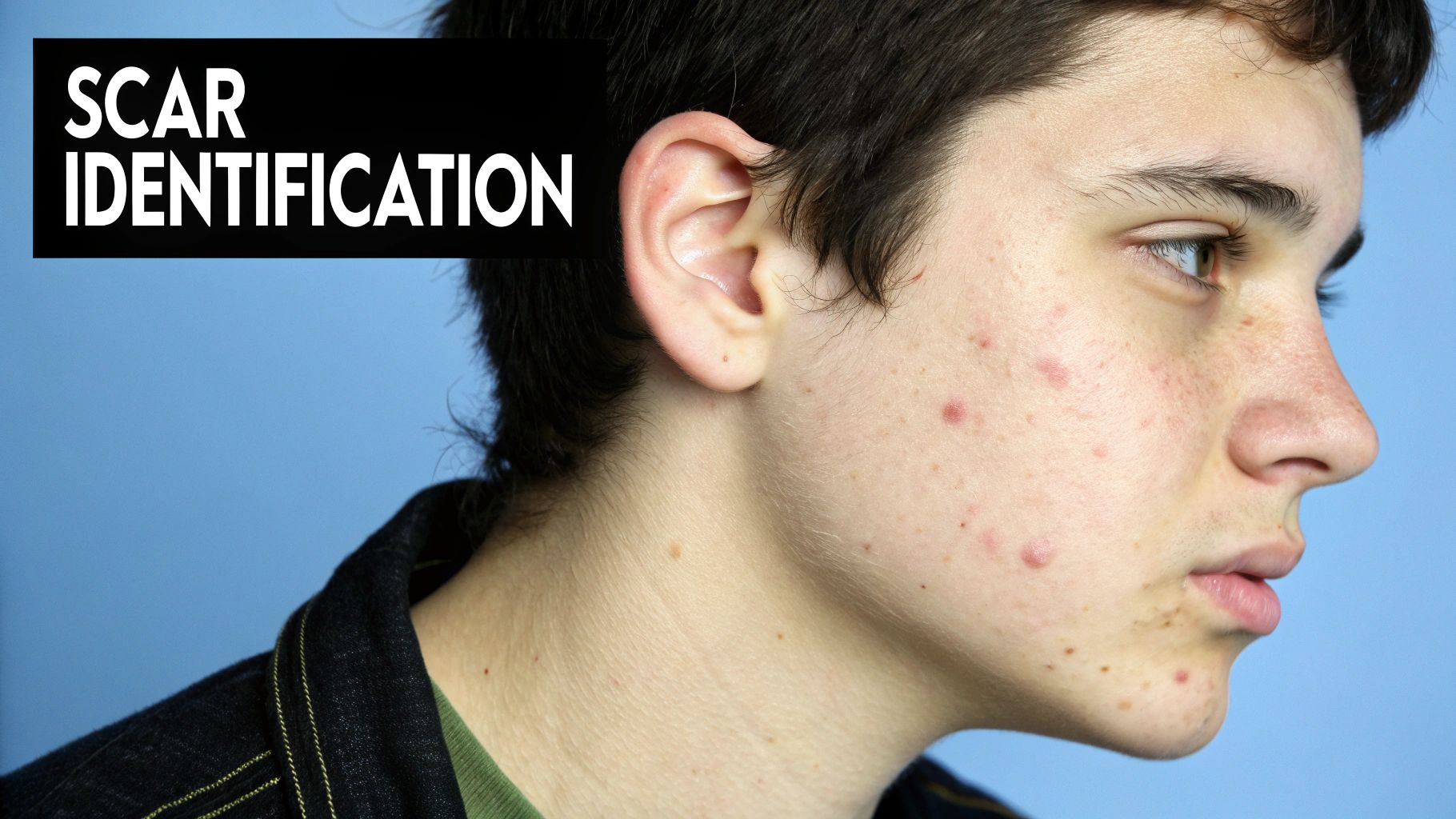
Think of yourself as a skin detective for a minute. Getting up close and personal with your skin is the only way to build a plan that gets results. Not every blemish leaves a permanent mark, and throwing the wrong products at the problem is a frustrating waste of time and money.
The big divide comes down to texture versus tone. Run your finger over the mark. Is it completely flat but colored differently than the rest of your skin? You're likely looking at post-inflammatory changes. If you can feel a distinct dip or a raised area, that’s a true scar.
The Two Main Categories of Acne Marks
It helps to think about the aftermath of acne in two buckets: marks left by inflammation and texture changes from collagen damage.
- Post-Inflammatory Discoloration: This is the stuff that eventually fades. It includes Post-Inflammatory Hyperpigmentation (PIH), which shows up as brown or dark spots from extra melanin production, and Post-Inflammatory Erythema (PIE), which looks like red or purple spots from damaged blood vessels near the skin's surface.
- True Atrophic Scars: These are the permanent indentations caused when your skin doesn't produce enough collagen as a deep pimple heals. They won't go away on their own and need treatments that focus on physically rebuilding the skin.
Getting this right is everything. A cream designed to fade dark spots won’t do a thing for a pitted scar, and a treatment meant to build collagen won't help with redness.
For a quick reference, here's a simple way to tell them apart.
Identifying Your Acne Marks At a Glance
| Mark Type | Appearance | Primary Cause |
|---|---|---|
| PIE | Flat red or purple spots | Damaged/dilated capillaries |
| PIH | Flat brown or dark spots | Overproduction of melanin |
| True Scar | Indented or raised texture | Loss or overgrowth of collagen |
This table makes it easy to see that if the mark is flat, you're dealing with discoloration. If it has texture, it's a scar.
Identifying Common Types of Atrophic Scars
When it comes to those indented scars, they usually fall into one of three categories. Each one looks a little different and often responds best to certain types of treatments.
True acne scarring is the result of permanent changes in the skin’s texture caused by the healing of deep, inflamed acne lesions. The body's repair process doesn't always result in smooth skin, leaving behind visible marks that affect the surface.
Learning to spot your specific scar type is the first step toward finding a solution that can make a real difference.
- Ice Pick Scars: These are deep, narrow, and V-shaped, almost like the skin was punctured with a tiny, sharp object. Because they're so deep, they are notoriously difficult to treat with at-home products alone.
- Boxcar Scars: Wider than ice pick scars, these have more defined, sharp edges and a U-shaped appearance. They can be shallow or deep and often look a lot like old chickenpox scars.
- Rolling Scars: These create a wave-like or undulating look on the skin's surface. They don't have sharp edges but instead have sloped sides that make the skin look uneven.
If you’re struggling with this, you're far from alone. The desire for smoother, more even-toned skin has created a huge industry. The market for scar treatments is projected to hit USD 15.9 billion by 2033. Topical solutions make up a dominant 61% market share, mostly because they are so accessible. You can read more about the growth in the acne scar treatment market news. This just goes to show how common this issue is and why people are searching for effective, science-backed solutions.
Powerful Ingredients for At-Home Treatment
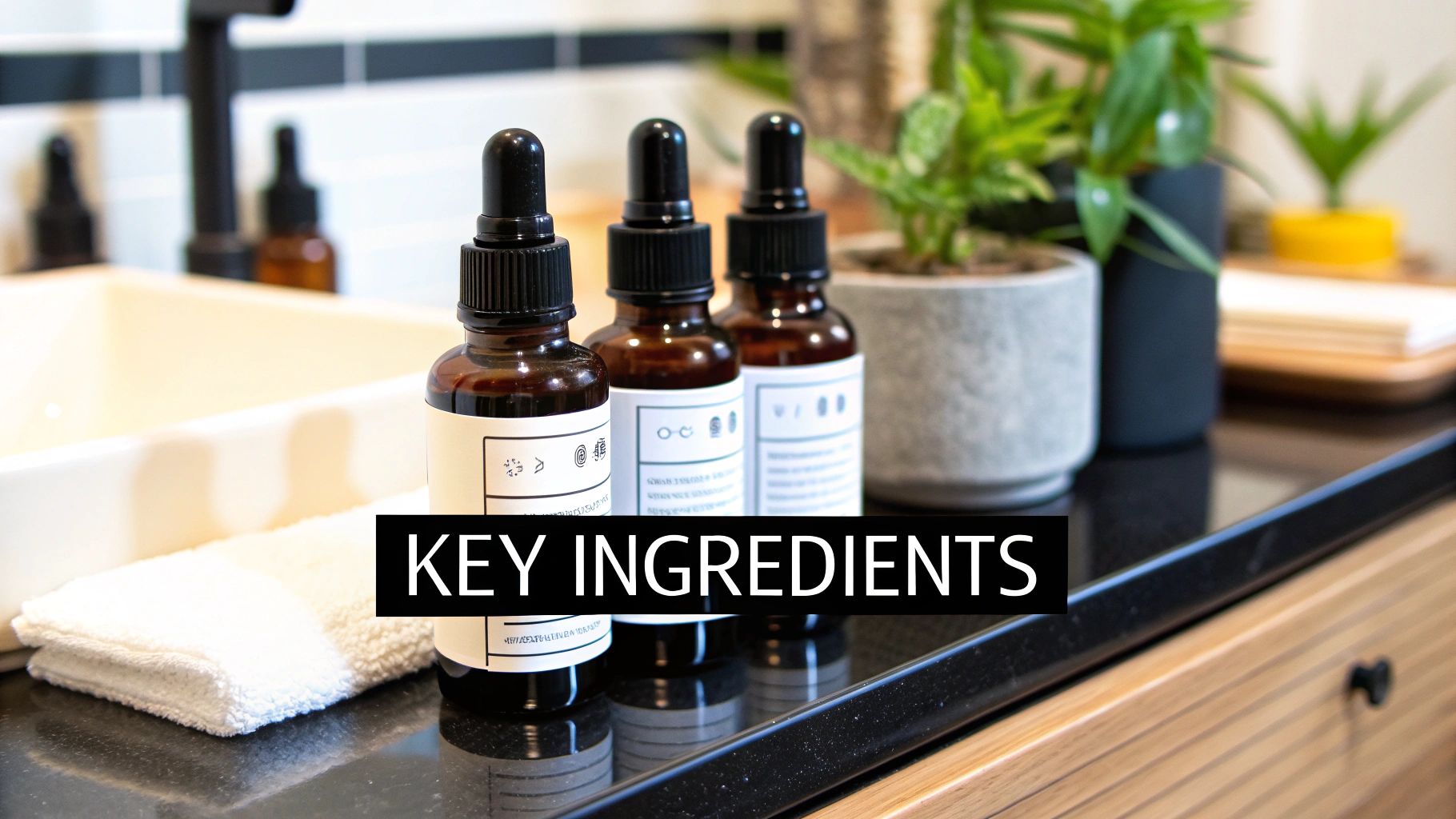
When you're trying to get rid of acne scars, the skincare aisle can feel overwhelming. But you don't need to be a scientist to get results. At Neutralyze, we’ve done the research for you. Our expertise is built on understanding which key ingredients actually work and, more importantly, how to combine them for maximum effect without irritation.
The goal is always the same: encourage your skin to renew itself. This is where a smart, multi-ingredient approach—the core of the Neutralyze philosophy—really shines. Our formulas expertly combine ingredients that exfoliate, soothe, and support your skin's built-in healing process.
The Gentle Power of Mandelic Acid
Let's start with Mandelic Acid, an Alpha Hydroxy Acid (AHA) derived from bitter almonds. What makes it so special? Its large molecular size allows it to penetrate the skin more slowly and evenly than other AHAs, making it significantly gentler. This is a massive win for sensitive or reactive skin.
Mandelic acid is a cornerstone of our formulations because it’s a superstar for tackling post-inflammatory hyperpigmentation (PIH). It works by dissolving the bonds holding dead, discolored cells to the surface, gently revealing the brighter, more even-toned skin underneath. This is the kind of targeted, effective action we build our products around.
Deep Cleaning with Salicylic Acid
While Mandelic Acid works on the surface, Salicylic Acid goes deeper. As an oil-soluble Beta Hydroxy Acid (BHA), its superpower is its ability to penetrate into pores and exfoliate from the inside out. This makes it a crucial ingredient for anyone dealing with scars and active breakouts.
We harness Salicylic Acid to clear out the debris that causes new pimples while simultaneously encouraging the shedding of scarred, pigmented cells. It’s your two-in-one weapon for preventing future marks and improving existing discoloration and shallow texture—a core benefit of the Neutralyze system.
Here's where the real magic happens: the Neutralyze combination. Pairing a gentle surface exfoliator like Mandelic Acid with a deep-cleaning BHA like Salicylic Acid creates a comprehensive resurfacing treatment. This is how we tackle discoloration and texture at the same time, delivering visible results without overwhelming your skin.
The Supportive Role of Niacinamide
Every effective skincare system needs a powerful support player, and for us, that's Niacinamide. This form of Vitamin B3 is the ultimate multitasker and the perfect partner for our exfoliating acids. Its main job is to strengthen your skin's natural moisture barrier.
A strong, healthy barrier is crucial for healing. Here’s what Niacinamide brings to our formulas:
- It calms things down: By reducing redness and inflammation, it helps your skin tolerate the active work of the acids.
- It improves elasticity: Firmer, more resilient skin is key to smoothing out textural irregularities.
- It fades dark spots: Niacinamide helps inhibit pigment transfer, stopping discoloration in its tracks.
To give your skin an extra boost from the inside out, you might also consider adding grass-fed collagen for radiant skin to your routine, which supports the skin’s natural structure.
When you use Mandelic Acid, Salicylic Acid, and Niacinamide together, you create a beautifully balanced system. The acids do the heavy lifting of cell turnover to fade scars, while Niacinamide keeps your skin calm, hydrated, and strong through it all. This kind of intelligent formulation is the Neutralyze difference, providing the best at-home solution for your skin.
When Professional Treatments Make Sense
While a great at-home routine is your first line of defense, some scars just won't budge with topicals alone. I'm talking about the textural scars—the indented ones like boxcar, ice pick, or rolling scars that create an uneven skin surface. When you're facing these, it’s probably time to call in a professional.
Think of it this way: your daily products are like ongoing maintenance for your home's appearance, keeping the paint fresh and the surfaces clean. Professional treatments, on the other hand, are the structural renovations. They work on a much deeper level to physically rebuild and remodel your skin's foundation, creating changes that creams and serums simply can't.
Understanding these options helps you walk into a dermatologist's office ready to have a productive, informed conversation.
Treatments That Trigger Collagen Production
So, how do these treatments actually work? Many of the most effective ones have a shared mission: to kickstart your skin’s own healing process and get it to produce new, healthy collagen. This process is called neocollagenesis, and it's the secret to filling in those depressed scars from the inside out.
Microneedling is a perfect example. A dermatologist uses a device with tiny, sterile needles to create thousands of controlled micro-injuries in the skin. This sounds intense, but it's a clever trick. The controlled damage signals your body to send a flood of collagen and elastin to the area, which gradually plumps and smooths the scarred tissue over a series of treatments.
Then there's laser resurfacing. Treatments like fractional CO2 lasers go even deeper, creating microscopic thermal zones in the skin. This removes the damaged tissue and triggers a powerful collagen-building response, essentially giving your skin a chance to heal into a much smoother, newer canvas.
This visual guide shows what that journey often looks like, from the initial assessment to the final regeneration.
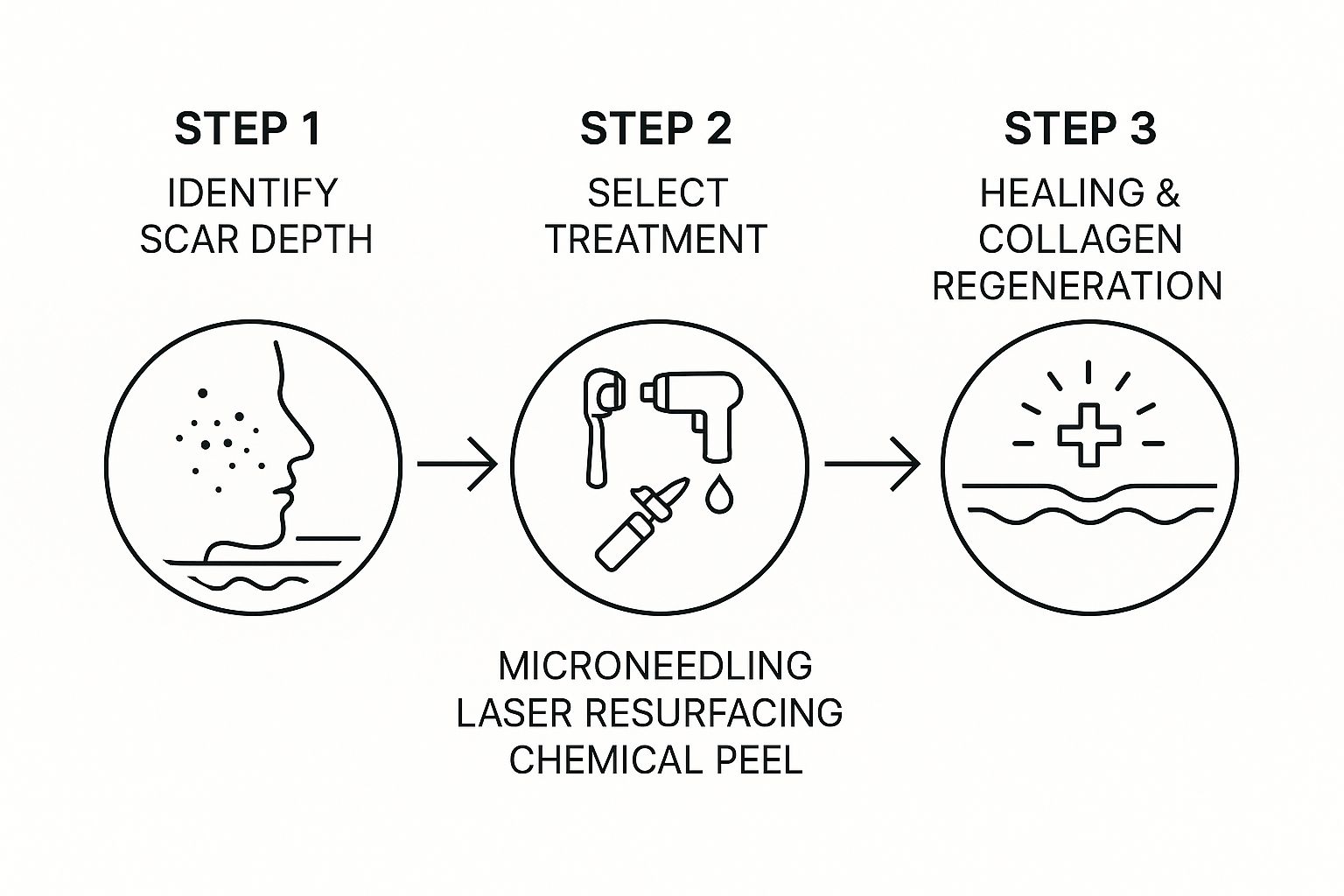
As you can see, the key to success is matching the right procedure to the specific type and depth of your scars.
Exploring Other Targeted Procedures
Beyond just building collagen, dermatologists have a few other specialized tools in their arsenal. Each one is designed for a particular kind of scar, which is why getting that professional diagnosis is so important.
Here are a few other common options:
- Chemical Peels: A professional-grade peel using something like Trichloroacetic Acid (TCA) can remove the damaged outer layers of skin. As your skin regenerates, it can dramatically improve the look of shallower atrophic scars.
- Subcision: This is the go-to for rolling scars. These scars are often pulled down by fibrous bands under the skin. A dermatologist inserts a special needle to break up these tethers, which releases the indentation and allows the skin to lift back up.
- Dermal Fillers: Need a more immediate fix for a few deep scars? A dermatologist can inject a filler (usually made of hyaluronic acid) directly underneath the depression. This physically lifts the scar, making it instantly level with the rest of your skin.
The demand for these kinds of solutions is huge. The global acne scar treatment market was valued at around USD 4.67 billion in 2025, driven largely by people seeking effective in-office procedures. You can discover more insights about the acne scar treatment market to see just how fast this area is growing. It shows a clear trend: more and more people are turning to the pros to get rid of their acne scars for good.
Building Your Anti-Scar Skincare Routine
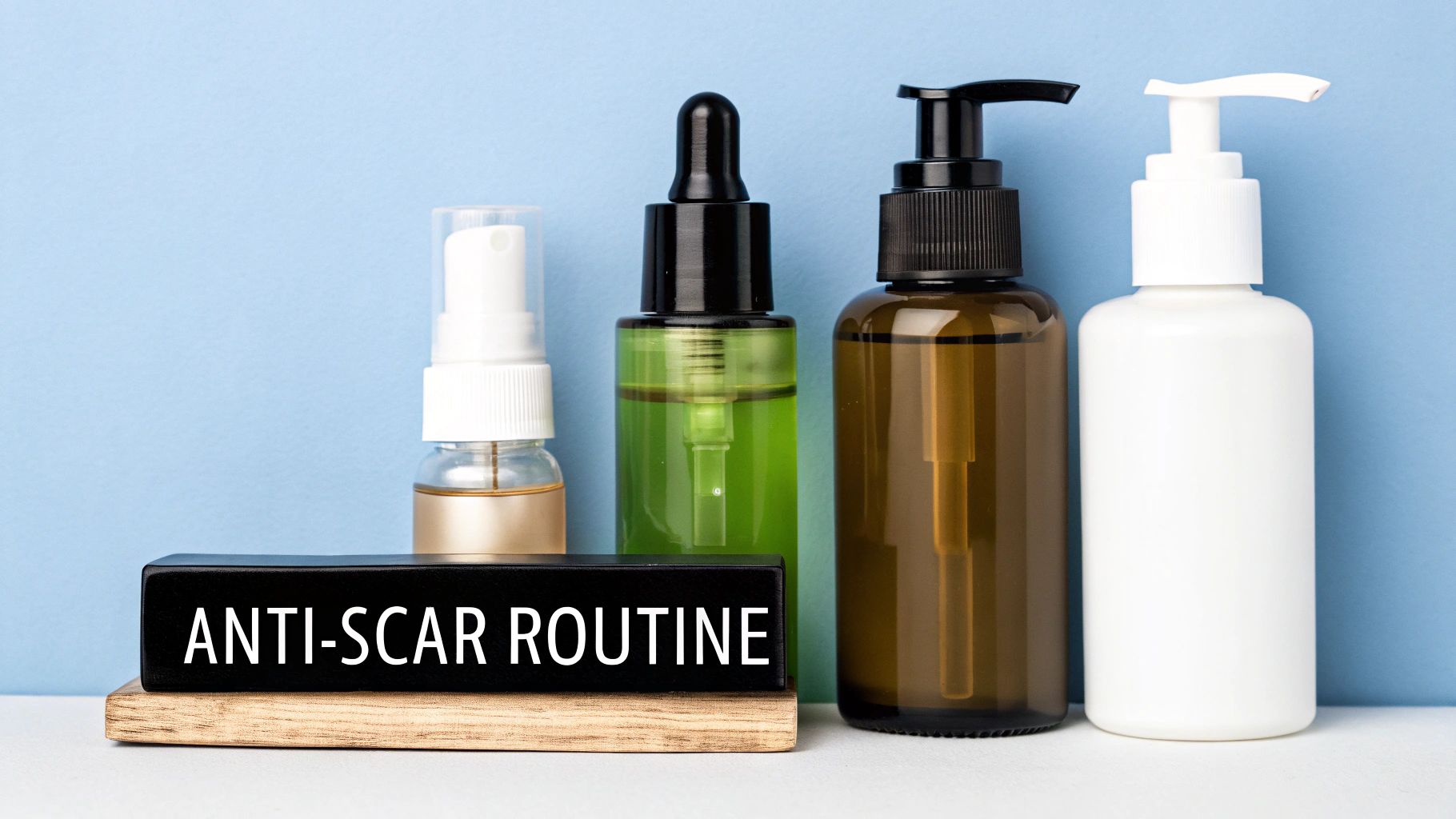
Knowing which ingredients fight scars is half the battle. The other half? Using them correctly. You won't see results without a consistent, smart routine that layers products for maximum impact—without turning your face into a red, irritated mess.
It all boils down to a simple day-and-night strategy. Think of your morning routine as your skin’s bodyguard and your evening routine as its repair crew.
Your morning (AM) routine is all about protection. Every day, your skin is under assault from UV rays and pollution, which can make dark spots even darker and slow down healing. A solid AM routine acts as a shield, letting your skin focus its energy on getting better.
Then, at night, the focus shifts to repair and renewal. Once the day is washed off, your skin is ready to soak up powerful, active ingredients. This is your prime time to use exfoliants that speed up cell turnover, helping to reveal smoother, more even-toned skin while you sleep.
Your Morning Shield: The Protective AM Routine
The best morning routines are simple and defensive. You’re just trying to prep your skin for the day and lock in a protective barrier, especially against the sun.
- Gentle Cleanse: Start with a mild, non-stripping cleanser. All you need to do is wash away sweat and oil from the night, not scrub your skin raw.
- Targeted Treatment: Follow up with a lightweight serum. A formula with Niacinamide is perfect for the morning; it helps calm any lingering inflammation and strengthens your skin’s natural barrier.
- Hydrate: A good moisturizer is non-negotiable. It seals in hydration and supports the protective barrier that the Niacinamide is working so hard to build.
- Protect with SPF: This is, without a doubt, the most important step for anyone dealing with acne scars. Sun exposure makes post-inflammatory hyperpigmentation (PIH) noticeably darker and much harder to fade. No excuses—use a broad-spectrum sunscreen with at least SPF 30 every single day.
Sunscreen isn't optional; it's your insurance policy. If you skip it, all the hard work your powerful nighttime products are doing gets undone by daily UV damage. You’ll just be stuck in a frustrating cycle.
Your Evening Crew: The Repairing PM Routine
Nighttime is when your skin naturally kicks into high gear for regeneration. Your routine should give it the tools it needs to exfoliate, resurface, and rebuild. This is where you’ll make real, visible progress on fading marks and smoothing out texture.
An effective PM routine is all about a deep clean followed by targeted exfoliation. This is when ingredients like Mandelic Acid and Salicylic Acid really get to shine.
- Clarifying Cleanse: First, wash away the day's grime, makeup, and sunscreen with a clarifying cleanser. Using one with Salicylic Acid gives you a head start on exfoliation by getting deep into the pores right from the first step.
- Exfoliating Treatment: After cleansing, it’s time for your main treatment. A powerful but well-formulated leave-on product is ideal here. The Neutralyze Exfoliating Pads, for example, combine Mandelic and Salicylic Acids to tackle discoloration on the surface and clear out pores from within.
- Moisturize: Always finish with a calming moisturizer. This soothes your skin after the active exfoliation step and keeps it hydrated overnight, preventing the potential dryness that acids can sometimes cause.
Sample Anti-Scar Skincare Routine
Putting it all together can feel overwhelming, so here’s a sample routine showing how you can layer these products to get the best results. This structure ensures each product can do its job without interference.
| Time of Day | Step | Product Type & Key Ingredient (Neutralyze Focus) | Purpose |
|---|---|---|---|
| Morning | Step 1 | Gentle Cleanser | Removes overnight oil and prepares skin for treatment without stripping. |
| (AM) | Step 2 | Serum with Niacinamide | Calms inflammation, strengthens the skin barrier, and reduces redness. |
| Step 3 | Hydrating Moisturizer | Locks in moisture and supports a healthy skin barrier. | |
| Step 4 | Broad-Spectrum SPF 30+ | Protects against UV damage, preventing scars from darkening. | |
| Evening | Step 1 | Clarifying Cleanser with Salicylic Acid | Deep cleans pores and removes daily buildup while starting the exfoliation process. |
| (PM) | Step 2 | Neutralyze Exfoliating Pads (Mandelic & Salicylic) | Accelerates cell turnover to fade discoloration and smooth skin texture. |
| Step 3 | Calming Moisturizer | Soothes skin post-exfoliation and provides overnight hydration to support repair. |
This deliberate split—protection by day, repair by night—creates a 24/7 system dedicated to fading old scars and stopping new ones from forming. Stick with it! Consistency is what ultimately gets you to clear, smooth, and even-toned skin.
Prevention Is Your Strongest Weapon
Look, while there are some incredible treatments out there for acne scars, the absolute best strategy is to stop them from ever showing up. It’s a proactive game that saves you a ton of time, money, and emotional energy later on. And it all boils down to one golden rule you’ve heard a million times but needs repeating: do not pick, pop, or squeeze your pimples.
Seriously, don't do it. When you squeeze a pimple, you're not just getting the gunk out; you're actually forcing bacteria and debris deeper into your skin. This triggers a massive inflammatory response, which is the direct cause of both pitted scars and those stubborn dark marks. You’re essentially trading a pimple that would last a few days for a scar that could last for months or even years.
Address Acne Quickly and Consistently
The next big thing is to jump on active acne the second it appears. The longer a big, angry, inflamed pimple is allowed to hang around, the more likely it is to damage the collagen deep within your skin. This is where a targeted, fast-acting treatment system becomes your secret weapon.
Using a proven solution like Neutralyze is key here, as it's specifically formulated to calm down that fiery inflammation and clear breakouts fast. By getting that redness and swelling under control right away, you cut off the process that leads to scarring. A good routine minimizes the damage before it has a chance to become a permanent change in your skin's texture or a dark spot that won't fade.
An ounce of prevention is truly worth a pound of cure. By focusing on controlling active acne, you’re not just clearing your skin for today—you’re actively protecting it from the future damage that becomes much harder to treat.
Embrace an Inside-Out Approach
Your skin is often a mirror of what’s happening inside your body. That means prevention goes way beyond what you put on your face. Certain lifestyle choices can either add fuel to the inflammatory fire or help keep it under control, which directly affects how well your skin heals without scarring.
To give your skin the best support from the inside, think about adopting these habits:
- Mind Your Diet: Load up on anti-inflammatory foods. Think leafy greens, colorful berries, and fish rich in omega-3s.
- Stay Hydrated: Drinking enough water is crucial for keeping your skin supple and supporting the natural cell turnover process.
- Manage Stress: We all know stress can trigger breakouts. Find what works for you—whether it's meditation, exercise, or just taking some quiet time.
While your skincare routine is front and center, some fascinating research is pointing toward a more holistic view of skin health. This includes looking at internal factors, and for some, exploring gut health supplements might be a helpful piece of the puzzle for overall well-being that shows on the skin. By creating a healthier internal environment, you're building more resilient skin from the ground up. You can learn more in our detailed guide on how to prevent acne scarring.
It's clear people are catching on. The global acne scar treatment market is booming, expected to jump from USD 3.89 billion in 2024 to a staggering USD 8.1 billion by 2035. This growth is largely because more and more people understand the importance of tackling this issue. If you're interested in the numbers, you can check out the full market analysis. It just goes to show how critical it is to get ahead of the problem.
Got Questions About Treating Acne Scars? Let's Talk.
When you're starting the journey to fade acne scars, a lot of questions pop up. It’s completely normal. Let's tackle some of the most common ones I hear, so you can move forward with a clear, confident plan.
"How Long Until I Actually See a Difference in My Scars?"
This is the big one, and the honest answer is: it depends. Patience is your best friend here.
If you're dealing with those stubborn dark spots (post-inflammatory hyperpigmentation), a consistent routine with ingredients like Mandelic Acid and a daily sunscreen habit can start showing real improvement in about 3-6 months.
For scars that have a texture to them—the indents or raised spots—at-home treatments can certainly soften their appearance over 6-12 months. But for a dramatic change, you'll likely need to bring in the pros for in-office procedures. Your personal timeline really comes down to the type and severity of your scars.
"Will Ingredients Like Salicylic Acid Even Work on Old Scars?"
Yes, they can make a surprising difference! While an acid won't completely erase a deep scar you've had for years, powerful exfoliants like Salicylic and Mandelic Acid are fantastic at speeding up your skin's natural renewal process.
Think of it as gently sloughing off the old, discolored, and damaged surface layers of skin. As those layers give way, fresher and healthier-looking skin is revealed. Over time, this consistent turnover makes old scars look shallower, smoother, and far less obvious. It's a key part of any effective at-home strategy.
Sunscreen is your non-negotiable secret weapon. UV rays trigger your skin to produce more melanin, which will make any dark spots you have darker and much harder to treat. Think of a daily SPF 30+ as the ultimate insurance policy for all your hard work.
"Do I Really Need to Wear Sunscreen for My Scars?"
One hundred percent, yes. This is probably the single most important step in your entire routine. UV radiation is a direct signal for your skin to pump out more melanin, which is the pigment that makes those post-acne dark spots so dark. Without sun protection, you’re fighting an uphill battle.
Not only that, but the sun actively breaks down collagen, the very thing your skin needs to fill in indented scars. So, sun exposure can actually make atrophic scars look deeper and more prominent. A broad-spectrum SPF of 30 or higher, every single day, is how you protect your progress.
"What’s the Difference Between a Scar and a Dark Spot Anyway?"
It all comes down to texture versus tone.
A dark spot, which dermatologists call post-inflammatory hyperpigmentation (PIH), is purely a color issue. It's a flat patch of discoloration left behind after a breakout has healed. The skin itself is still smooth to the touch.
A true acne scar, on the other hand, involves a change in the skin's texture. It's either a dip or an indent from a loss of collagen (an atrophic scar), or it's a raised, bumpy lesion from an overproduction of collagen (a hypertrophic scar). Knowing which one you have is crucial because they require totally different treatment plans.
Ready to build a routine that puts these powerful ingredients to work? The products from Neutralyze are specifically formulated to deliver Salicylic Acid, Mandelic Acid, and Niacinamide in a smart, balanced system. Explore the complete collection on the Neutralyze website and start your journey toward clear, even-toned skin today.


